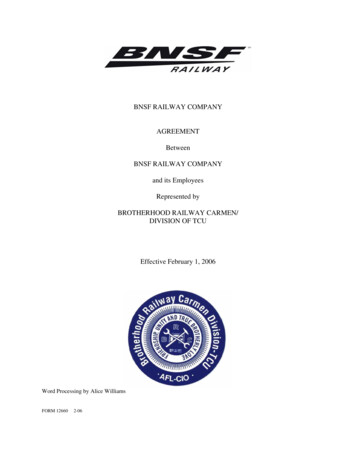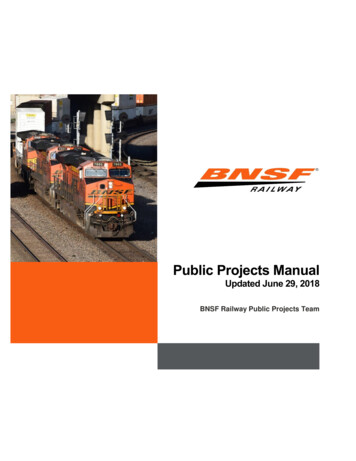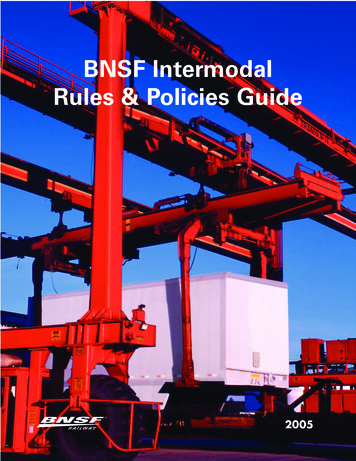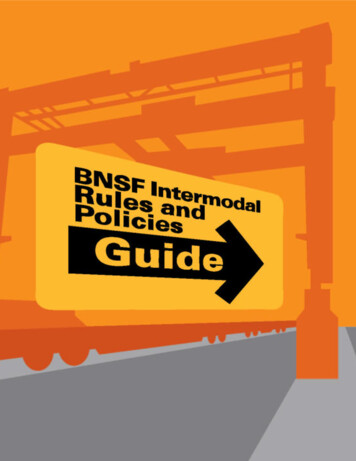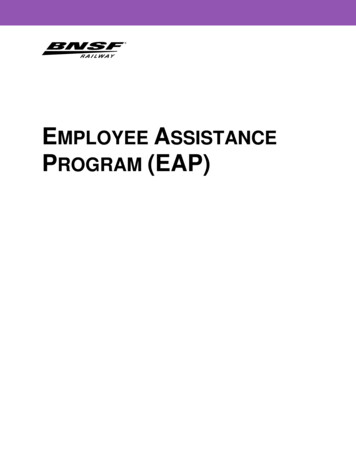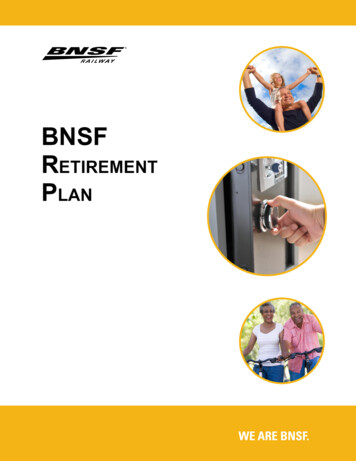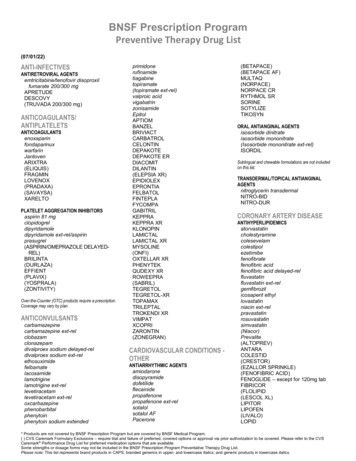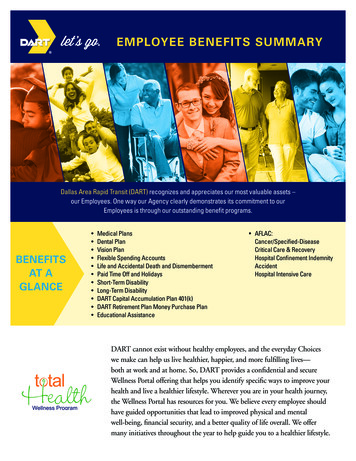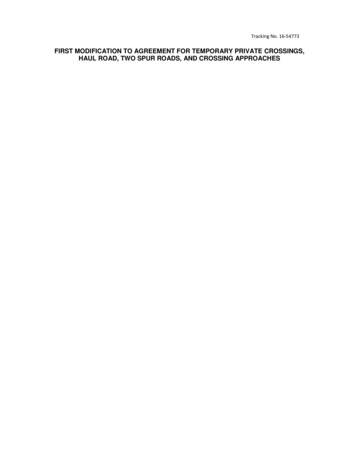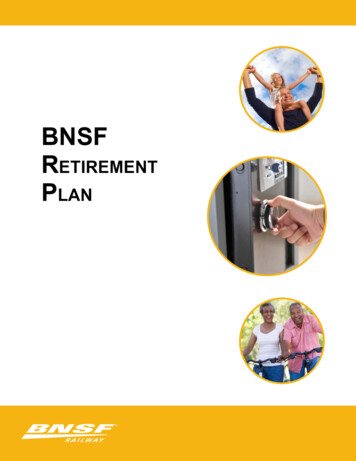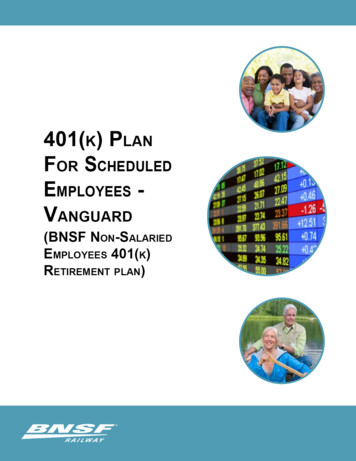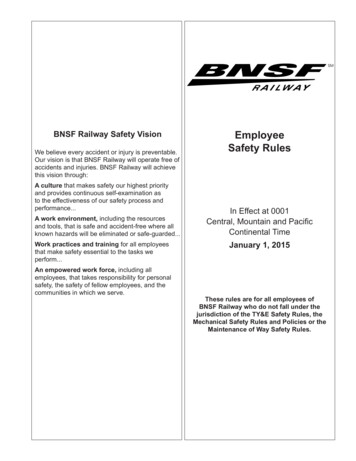
Transcription
BNSF Railway Safety VisionWe believe every accident or injury is preventable.Our vision is that BNSF Railway will operate free ofaccidents and injuries. BNSF Railway will achievethis vision through:A culture that makes safety our highest priorityand provides continuous self-examination asto the effectiveness of our safety process andperformance.A work environment, including the resourcesand tools, that is safe and accident-free where allknown hazards will be eliminated or safe-guarded.Work practices and training for all employeesthat make safety essential to the tasks weperform.An empowered work force, including allemployees, that takes responsibility for personalsafety, the safety of fellow employees, and thecommunities in which we serve.EmployeeSafety RulesIn Effect at 0001Central, Mountain and PacificContinental TimeJanuary 1, 2015These rules are for all employees ofBNSF Railway who do not fall under thejurisdiction of the TY&E Safety Rules, theMechanical Safety Rules and Policies or theMaintenance of Way Safety Rules.
2Employee Safety Rules—January 1, 2015Table of ContentsS-1.0S-1.1S-1.2Core Safety Rules. 7Job Safety Briefing. 7Rights and Responsibilities. 8S-2.11Chemical Approval. 16S-2.12Biohazard Safety. 16S-3.0Electrical Safety. 17S-3.3S-3.1.1General. 17S-3.1.2Authorized Employees. 17S-3.1.3Warning Signs. 17S-3.1.4Flashlights. 17S-3.1.5Contacts. 17S-3.1.6Lockout/Tagout. 17Charging and Jumping Batteries. ents. 17S-1.4Sufficient Time . 8Authorized and Trained. 8Alert and Attentive. 8Co-Workers Warned. 8Safety Rules, Mandates,Instructions, Training Practices andPolicies. 8S-1.2.6Warning Signs. 8S-1.2.7Two or More People. 8S-1.2.8Reporting. 8S-1.2.9Horseplay. 8S-1.2.10 “Bill of Rights” Relative toEmployees Riding in TransportVehicles. 9S-1.2.11 Medical Conditions. 10S-1.2.12 Medical Examinations. 10S-1.2.13 Conflict of Interest. 10S-1.2.15 Good Faith Challenge. 11Tools and Equipment. 12S-1.5S-1.4.1Inspection. 12S-1.4.2Use as Intended. 12S-1.4.3Manufacturer Specifications. 12S-1.4.4Manufacturer Approval. 12S-1.4.5On or Off Moving Equipment. 12S-1.4.6Three-Point Contact. 12Work Environment. 12S-5.4Defective Fire Extinguishers. 19Access to Fire Extinguishers andProtection Devices . 19S-5.3.3Use of Gasoline/Oil-BurningDevices. 19S-5.3.4Open Flames. 19Starting Fires. 19S-5.5Fueling Vehicles, Machinery and Equipment. 20S-5.6Electrical Circuits. 20S-5.8Use and Handling of Liquefied Petroleum Gas(LPG). 20S-1.6S-1.5.1Housekeeping. 12S-1.5.2Inspection. 13S-1.5.3Footing. 13S-1.5.4Confined Spaces. 13S-1.5.5Hazardous Materials. 13S-1.5.6Smoking. 13S-1.5.7Sexual Harassment. 13S-1.5.8Retaliation. 14Working On or About Tracks. 14S-1.6.1S-1.6.2Movement of Equipment. 14Employees Fouling the Track. 14S-5.9Chemical Safety. 15S-7.0Hand Tools. 21S-7.3Precautions During Use. 21S-2.0S-2.1Environmental Safety. s for Servicing Batteries. 17Battery Flushing. 18Metallic Objects. 18Jumping Batteries. 18Fire Prevention, Response, andHazards. 19General Requirements. 19S-5.2Emergency Procedures. 19S-5.3S-5.2.1Locomotive Fires. 19S-5.2.2Right of Way Fires. 19Fire Extinguishers and Protection Devices. 19S-5.3.1S-5.3.2S-5.8.1Testing. 20S-5.8.2Avoiding Extreme Heat. 20S-5.8.3Handling Leaks. 20S-5.8.4Refueling LPG Tanks. 20S-5.8.5Closing Valves. 20Refrigeration Systems. 20S-5.9.1S-7.1Qualified Employees. 20Hand Tool Inspection. 21S-2.2Chemical Spills and Chemical Releases to Air. 15S-2.3Labeling Chemical Containers. 15S-2.4Ventilation for Maintaining Safe Atmospheres. 15S-2.5Skin Cleaning. 15S-2.6Containment and Spill Prevention. 16S-7.4S-7.3.1Swinging Tools. 21S-7.3.2Jacks. 21S-7.3.3Tools With Sharp Edges/Blades. 21Pry/Lining Bars. 21S-2.8Protection from Asbestos Exposure. 16S-7.7Correct Tool Use. 21S-8.0Intermodal/Automotive Facility Safety. 23S-2.10S-2.8.1Repair and Maintenance. 16S-2.8.2Training. 16Protection from Silica-Containing Dust. 16
3Employee Safety Rules—January 1, 2015S-8.1Core Intermodal/Automotive Facility SafetyRules. 23S-9.7Instructions for Climbing . 40S-8.2Blue Signal Protection of Intermodal andAutomotive Workmen. 23S-9.8S-9.7.1Climbing with Tools or Materials . 40Performing Work . 40S-8.2.1S-8.2.2S-8.2.3S-8.2.7S-9.9Extension Ladders . 40S-9.10Step Ladders . . 40S-9.11Construction Scaffolding . 40S-9.12S-9.11.1 Sectional Metal Scaffolds . . 40Non-Powered Mobile Scaffolding . . 41S-9.13Aerial Work Platforms . 41S-8.3S-8.4Definitions . 23What a Blue Signal Signifies . 24How to Provide Protection . 24Blue Signal Readily Visible toEngineer . . 26S-8.2.13 Track Protection—Intermodal andAutomotive. 26Vehicles within Intermodal Facility. 27S-8.3.1Vehicle Requirements. 27S-8.3.2Vehicle Operations . 27S-8.3.3Bare Chassis Parking and Staging. 28S-8.3.4Hostling Specialized Equipment. 28S-8.3.5Shifted/Leaning Loads. 29Manned Check Point Ingate/OutgateProcedures. 30S-8.4.1S-8.5Intermodal—Manned CheckpointIngate/Outgate Procedures. 30S-8.4.2Intermodal—Temporary MannedCheckpoint Ingate/OutgateProcedures for Automated GateSystems . 31Leaking Units . 31S-8.6Crane Maintenance Area . 31S-8.7Riding in or on Intermodal Equipment . . 31S-8.8Mechanical Employee Protection WhileRepairing a Rail Car on an Intermodal RampTrack. 32S-8.9Items Allowed inside of the TireRepair Vehicle . 33Trailer Repair —Mobile Vehicle/BNSFMechanical Vehicle. 34S-11.1Material Storage . . 43S-11.2S-11.1.1 Stacking Material . 43S-11.1.2 Overhead Clearance . 43S-11.1.3 Storing Combustibles . 43S-11.1.4 Storage Racks . 43Hand Trucks . 43S-11.3Pallet Use and Stacking . 43S-11.4Loading and Unloading Cars, Trucks, andTrailers . 43S-11.5Sharp Edges . 44S-11.6S-11.5.1 Banding Material . 44S-11.5.2 Sharp Edges/Slivers—Metal. 44S-11.5.3 Sharp Edges/Nails—Wood. 44Wheelsets . 44S-11.7Hazardous Material Handling . . 44S-11.8S-11.7.1 Complying with Regulations . . 44S-11.7.2 Loading or Unloading Tank Cars . . 45S-11.7.3 Handling Fluorescent/Neon Tubes . . 45S-11.7.4 Disposing of Spray Containers . 45Forklifts. 45S-11.8.1S-11.8.2S-8.10.1S-8.11Equipment Allowed Inside of TrailerRepair Vehicle. 35Intermodal Equipment Repair and RepairShops . on. 37Jacking and Supporting Trailers. 37Repairing Trailers, Chassis andContainers. 37Automotive Facilities. 37S-11.9Inspection . . 39Storage . 39S-9.3Stage Boards . 39S-9.4Safety Feet . . 39S-9.5Ladder and Scaffold Placement . 39S-9.6Ladders for Electrical Work . 39Parking Requirements. 45Dismounting Forklift—Attended andUnattended Forklifts. 45S-11.8.3 Passengers. 45S-11.8.4 Tool Storage. 46S-11.8.5 Seat Belts. 46Forklift Operation. S-11.9.7S-11.9.8S-11.9.9Ladders, Platforms, Scaffolds, andAerial Baskets. 39S-9.2Scissor Lifts . . 41Boom-Mounted Baskets or Buckets .41S-11.0 Material Handling . 43Tire Repair—Mobile Vehicle Requirements(Outside of Vehicle). 33S-8.9.1S-8.10S-9.13.1S-9.13.2Speed and Movement Restrictions . 46Getting On or Off . . 46Operation on Ramps . 46Gates/Doors . 46Load Limits . . 46Unloaded Fork Position . . 46Personnel Baskets . 46Inspections . 47Fueling a Forklift . 47S-12.0 Motor Vehicles and Trailers . 49S-12.1Operation of Motor Vehicles . . 49S-12.1.1General Requirements . 49
4Employee Safety Rules—January 1, 2015S-12.2S-12.1.2 Crossing Tracks . 49All-Terrain Vehicles (ATVs) . 50S-12.3Motorcycle Use . 50S-12.4Utility Vehicles . 50S-12.5Seat Belts . . 50S-12.6Passengers . 50S-12.7Maintenance/Inspections . 50S-12.8Backing . 51S-12.9Parking . 51S-15.1Storing Gas Cylinders . 63S-12.9.1 Fouling Tracks or Roadways . . 51S-12.10 Work Under Vehicles or Trailers . 51S-15.2Testing for and Handling Leaks. 63S-12.12 Special Equipment Mounted on Vehicles orTrailers . 52S-15.3S-15.2.1 Testing for Leaks . 63S-15.2.2 Handling Leaks . 63Mixing Gases . 63S-15.4Handling and Transporting Gas Cylinders . 64S-12.13 Trailers . 52S-15.5Changing Gas Cylinders . 64S-12.13.1 Required Equipment . 52S-12.13.2 Inspection . . 52S-12.14 Commercial Motor Vehicles. 52S-20.0 Work Environment . . 65S-12.11 Transporting Tools and Material . 51S-12.14.1 Commercial Motor Vehicle DriverFitness. 52S-12.14.2 Commercial Motor VehiclesTransporting Hazardous Materials. 53S-12.14.3 Commercial Motor Vehicle andTrailer Maintenance and Inspection. 53S-12.14.4 Commercial Motor Vehicle CargoSecurement. 53S-12.14.5 Commercial Motor Vehicle Hours ofService. 53S-12.14.6 Commercial Motor Vehicle SafeOperation. 53S-12.14.7 Commercial Motor Vehicle (CMV)Restrictions . 54S-12.15 Clerical Instructions for Transporting BNSFTY&E Crews . eral . 54Before Operating the Vehicle . 54When Picking Up Employees . . 54When Traveling . 56Clerical Employees Hauling Crews. 56S-13.0 On or Near Tracks, Locomotives andRail Cars . 57S-13.7.6S-13.8Switches Equipped with Locks,Hooks or Latches . 61S-13.7.7 Hand-Operated CrossoverSwitches . . 61Fusees. 61S-13.8.1S-13.8.2Storing Fusees . 61Disposing of Damaged Fusees . 61S-15.0 Oxygen and Fuel Gas. 63S-20.1Protection for Openings . 65S-20.2Clearances and Obstructions . . 65S-20.3S-20.2.1 Overhead and Side Obstructions . 65S-20.2.2 Communication/Signal Wires . 65Confined Space . 65S-20.4Machine Operation . . 65S-20.5Office Environment . S-20.5.7Office Equipment Arrangement . 65Filing Cabinets and Desks . 65Chairs . . 65Cords . 65Paper Cutters . 65Reaching Overhead . 65Folding and Four-Point OfficeChairs . . 66S-20.16 Precaution with Roll-Up Doors . 66S-21.0 Personal Protective Equipment (PPE) . . 67S-21.1Personal Protective Equipment Requirements. 67S-21.2Safety Eyewear. 69S-21.3Hard Hat. 71S-21.4Hand Protection. 71S-21.5Enhanced Visibility Work Wear. 73S-13.1General Requirements . 57S-21.6Hearing Protection. 74Safety Footwear. 74S-21.8Respirator Selection and Use . 75S-13.7S-13.1.3 Tracks . 57S-13.1.4 Sitting or Standing . . 57Operating Switches and Derails . . ecking for Damage andObstructions . 58Operating Ground Throw or “FlopOver” Switch . 59Operating High Stand/Low StandSwitch . 60Operating Switch Point Locks . 60Switch Heaters . 61S-22.0 Movement of Trains and Engines. 77S-22.1Inspecting Passing Trains. 77S-23.0 Railroad Radio Rules . 79S-23.1Transmitting . 79S-23.2Required Identification . 79S-23.3Repetition . 79S-23.4Over . 79
Employee Safety Rules—January 1, 20155S-23.5Out . 79S-28.12 Weapons . 90S-23.6Communication Not Understood or Incomplete .79S-28.13 Reporting and Complying with Instructions . . 90S-23.7Monitoring Radio Transmissions . 80S-28.14 Duty—Reporting or Absence . 90S-23.8Acknowledgment . . 80S-28.15 Subject to Call . 91S-23.9Misuse of Radio Communications . 80S-28.16 Hours of Service Law . 91S-23.10 Emergency Calls . 80S-28.17 Unauthorized Employment . . 91S-23.11 Prohibited Transmissions . 80S-28.18 Care of Property . . 91S-23.12 Fixed Signal Information . 80S-28.18.1 Company Vehicles . 91S-28.20 Occupying Roof . 91S-23.13 In Place of Hand Signals . . 80S-23.14 Transmitting Track Warrants and TrackBulletins . 81S-28.21 Not Permitted on Equipment . 91S-23.15 Phonetic Alphabet . 81S-28.21.1 Unauthorized People . 91S-28.22 Altering Equipment . . 92S-23.16 Assigned Frequencies . 81S-28.23 Clean Property . 92S-23.17 Radio Testing . 81S-28.23.1 Avoid Littering . 92S-28.24 Credit or Property . . 92S-23.18 Malfunctioning Radio . 81S-23.19 Blasting Operations . . 81S-23.20 Internal Adjustments . 81S-23.21 Mobile Radio Access System (MARS) . 81S-25.0 Job Tools . . 83S-25.2Physical Exertion . 83S-25.2.1Stretches. 83S-28.0 General Responsibilities . 85S-28.1Safety . 85S-28.2S-28.1.1 Maintaining a Safe Course . . 85S-28.1.2 Alert and Attentive . 85S-28.1.3 Accidents, Injuries, and Defects . . 85S-28.1.4 Condition of Equipment and Tools . 85S-28.1.5 Inspection After Derailment . 85Personal Injuries and Accidents . 85S-28.3S-28.2.1 Care for Injured . 85S-28.2.2 Witnesses . 85S-28.2.3 Equipment Inspection . 86S-28.2.4 Mechanical Inspection . 86S-28.2.5 Reporting . 86S-28.2.6 Statements . 87S-28.2.7 Furnishing Information . 87Rules . 87S-28.3.1S-28.4Rules, Regulations, andInstructions . . 87S-28.3.2 General Orders and Notices . 88Carrying Out Rules and Reporting Violations . 88S-28.5Drugs and Alcohol . 88S-28.6Conduct . . 88S-28.7S-28.6.1 Suitable Language . 89S-28.6.2 Notification of Felony Convictions . 89Altercations . 89S-28.8Appearance . . 89S-28.9Respect of Railroad Company . 89S-28.10 Games, Reading, or Electronic Devices . 89S-28.11 Sleeping . 90S-28.24.1 Proper Use of Postage . . 92S-28.25 Gratuities . . 92S-28.26 Divulging Information . 92S-28.26.1 Requirements for DisclosingCompany Information . . 93S-28.26.2 Monitoring of Company Information .93S-28.27 Fire . 93S-28.61 Encroachment . 93S-28.61.1 Authorized on Railroad Property . 93S-28.62 Legal Summons . 94Glossary. 95
6Employee Safety Rules—January 1, 2015This page left blank intentionally.
Employee Safety Rules—January 1, 20157At BNSF Railway, our vision is that we will operate free of accidents and injuries. We work in a safe but unforgivingenvironment with real risk for incidents with serious consequences. Life/safety critical rules were put in place toprevent serious injuries and fatalities.Rules and procedures: Outline expected practices, set standards and provide a basis for safety training. Help us identify and control or minimize risk.Written rules and procedures cannot protect us; they are merely words. To protect ourselves, we must individuallycommit to and comply with them. Understanding and appropriately applying rules and procedures are part of BNSFRailway’s proactive safety efforts. Our goal is that we all go home safely at the end of the shift.S-1.0Core Safety RulesS-1.1Job Safety BriefingEmployees will participate in a job safety briefing at the beginning of the shift, before changing jobsand as conditions change. This briefing must include a discussion of the tasks to be performed,present exposures and the associated risks, along with methods to control or minimize any such risks.Employees will identify opportunities throughout the duration of each task to pause the work and rebrief, such as when conditions surrounding the task change. To help in preparing an effective job safetybriefing, the following should be considered:WhoAll individuals involved in the tasks, or who are in the work area, must be included in the job safetybriefing; including, but not limited to, immediate crew members, supporting or adjacent crew members,supervisors, outside parties or contractors, and other work groups.WhatAn engaging, two-way dialogue to ensure that all individuals involved understand the tasks to beperformed. This includes a discussion of the tasks, identifying present exposures and the associatedrisks that are or will be present in the tasks, and reviewing ways to control or minimize such risks. If yousee a better way to perform a task, or are not confident in your understanding, talk about it.WhyTo ensure that tasks are done safely and efficiently, without injury or incident, meeting or exceedingBNSF standards.WhenAt the beginning of the shift, before changing jobs and as conditions change.WhereAt the work site, in the depot, break room, or locker room, or wherever all individuals involved cangather.HowThe following elements are essential to any job safety briefing: Review of the tasks. Identification of exposures and the associated risks. Assignment of duties and responsibilities. Required tools, equipment, materials, processes, and procedures. Methods for controlling or minimizing risk. Opportunities to pause the work and re-brief. Debriefing at the end of the tasks.
8Employee Safety Rules—January 1, 2015At the conclusion of your job safety briefing, all individuals involved must be able to answer thefollowing questions: What tasks will we be performing? What will we be doing? What are the processes we must follow to complete the tasks? What exposures are present in the tasks, and what are the associated risks? What can we do to control or minimize the risks? What should we do if conditions surrounding the tasks change? When should we pause the work and re-brief?S-1.2Rights and ResponsibilitiesWe have the right and responsibility to perform our work safely. Our training, skills, work experience,and personal judgment provide the foundation for making safe decisions about work practices.S-1.2.1Sufficient TimeS-1.2.2Authorized and TrainedS-1.2.3Alert and AttentiveS-1.2.4Co-Workers WarnedS-1.2.5Safety Rules, Mandates, Instructions, Training Practices andPoliciesTake sufficient time to perform job tasks safely.Perform job tasks only when authorized and trained to perform them.Assure that you are alert and attentive when performing duties.Warn co-workers of all unsafe practices and/or conditions.Comply with all applicable safety rules, mandates, instructions, training practices, andpolicies. BNSF Policies can be found on the BNSF Intranet. Employees without Intranet access may request a copy of any applicable policy from asupervisor.S-1.2.6Warning SignsS-1.2.7Two or More PeopleS-1.2.8ReportingS-1.2.9HorseplayComply with verbal warnings, warning signs, posted instructions, and placards identifyingrestricted areas, safety and health precautions, or potential hazards.Do not perform a task alone that can only safely be performed by two or more people.Make reports of incidents immediately to the proper manager.Conduct yourself in a way that supports a safe work environment free of horseplay,practical jokes, and harassment.
Employee Safety Rules—January 1, 2015S-1.2.109“Bill of Rights” Relative to Employees Riding in TransportVehiclesA large percentage of our employees are transported to and from various locations. Toensure safety issues are addressed while transporting in vehicles, all employees areempowered to take the necessary steps to ensure a safe workplace for ourselves and ourco-workers. Exercise the following rights with regard to riding in transport vehicles.Right 1Expect transport vehicles to be properly serviced, maintained, and in good working order.In addition, contract vans must be clean with all seat belts and all safety appliancesworking.Right 2Expect a safety briefing regarding movements to be made, route to be taken, location ofsafety appliances, i.e. fire extinguisher, first aid kit, emergency response plan in the eventof a medical emergency, etc.Right 3Expect the vehicle to be parked in the most accessible, safest location closest tothe passenger pick up/drop off location. Consider the surrounding area and vehicleclearances when positioning the vehicle. When practical, stop the vehicle off any publicroadways.Right 4Expect the vehicle to be secured against movement a
BNSF Railway who do not fall under the jurisdiction of the TY&E Safety Rules, the Mechanical Safety Rules and Policies or the Maintenance of Way Safety Rules. BNSF Railway Safety Vision We believe every accident or injury is preventable. Our vision is that BNSF Railway will operate free of accidents and injuries. BNSF Railway will achieve
